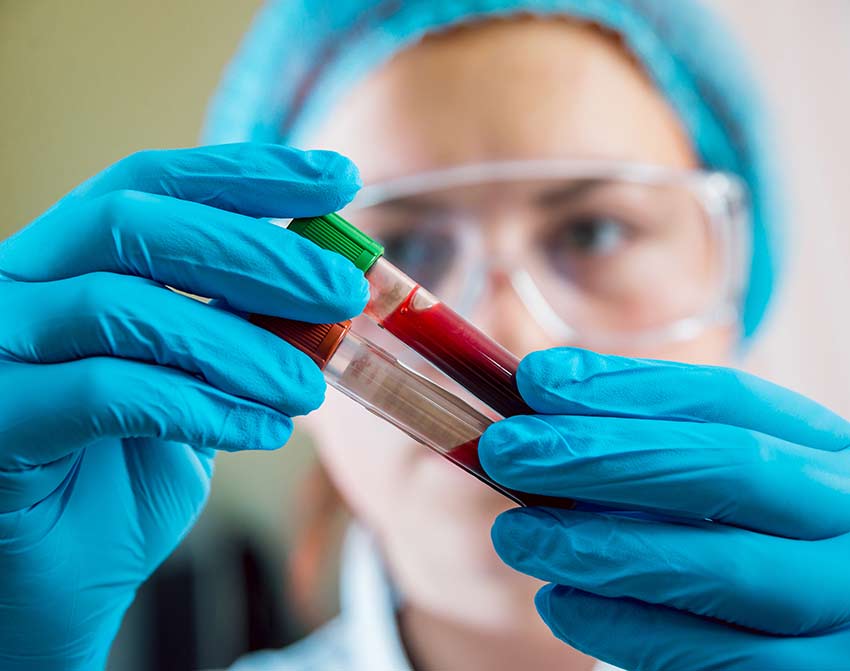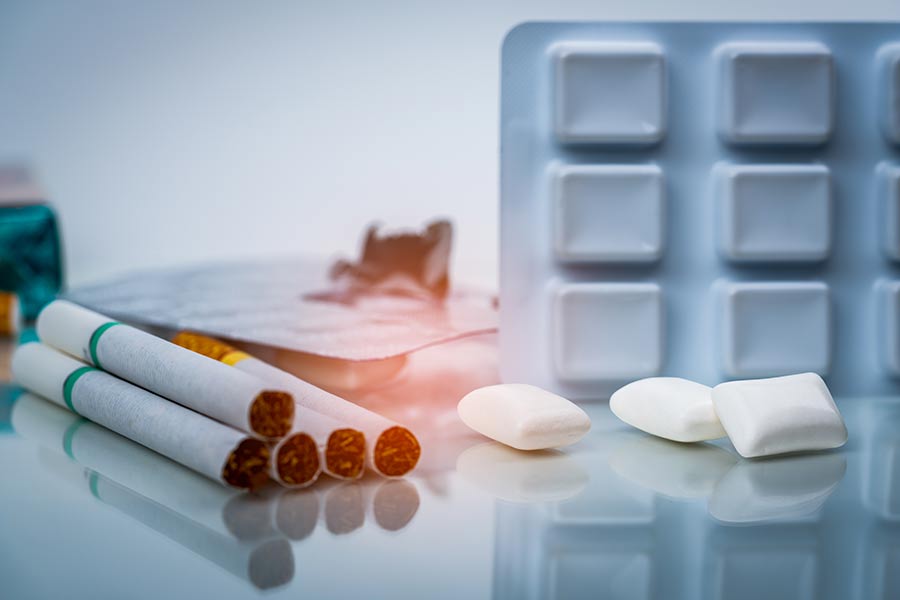How long does nicotine stay in your system after you quit smoking? And how long do other tobacco toxins (like arsenic or cadmium) stay in your system?
There are many different reasons why you might want to know how long nicotine stays in your body.
You may be interested in quitting smoking so you want to know how long the physical withdrawal from nicotine is likely to last.
Maybe you want to know how long it will take for your body to feel healthier.
Or maybe, you might be tested for evidence of tobacco use.
Some companies–hospitals, for example–may require prospective employees to be tested for tobacco use before a job offer is finalized. You might also encounter other situations when nicotine testing is required, like preparing for a surgery or applying for insurance.
First, we’ll talk about how long nicotine stays in your system and then about other tobacco toxins.
How Your Body Expels Nicotine
Before discussing how nicotine leaves your body, let’s talk about how nicotine is absorbed into your body.
Nicotine Absorption
When you inhale, cigarette smoke is drawn into your lungs. Tiny air sacs called alveoli line the lungs. Oxygen passes into the alveoli and then into the small blood vessels called capillaries that surround them.
If there’s cigarette smoke in your lungs, nicotine and other substances in the smoke pass into the alveoli and capillaries, too. That’s how nicotine is absorbed into your body.
If you smoke a pipe or cigar, or if you use smokeless tobacco, nicotine is absorbed through the membranes lining your mouth, rather than through your lungs.
Once nicotine is absorbed, it travels to your brain and body through the bloodstream.
Nicotine Metabolism and Elimination
Most of the nicotine is metabolized (broken down) by liver enzymes. There are six main metabolites, or breakdown products. The most important one is a substance called cotinine.
About 70 to 80 percent of the nicotine absorbed by the body is converted into cotinine.
The cotinine is broken down further into still other metabolites.
Then the metabolites are eliminated from the body in the urine.

How Long Does Nicotine Stay in Your System?
Nicotine is eliminated from the body much more quickly than cotinine.
Nicotine has a half-life of about 2 hours. Half-life is the amount of time it takes for 50 percent of a substance to be eliminated from the body.
Nicotine’s half-life is very short, with about 50 percent of it removed from the body in 2 hours.
So how long does nicotine stay in your system? In about 3 to 5 days after your last cigarette, nicotine has been largely eliminated from the body.
How Long Does Cotinine Stay in Your System?
Cotinine is metabolized and eliminated from the body much more slowly than nicotine. While the half-life of nicotine is about 2 hours, the half-life of cotinine is about 15 hours.
It can take more than 2 weeks for cotinine levels to drop to those typical of a nonsmoker. And for some heavy smokers, it can take about 3 weeks.
Nicotine testing actually tests for cotinine, not nicotine itself. That’s because cotinine can be detected much longer than nicotine can.
The only source of cotinine is nicotine, so if cotinine is found, it means there was nicotine in your body.
What Affects How Long Nicotine and Cotinine Stay in Your System?
As with almost everything else, the elimination time varies from person to person.
There are differences from one person to another in how much nicotine is converted into cotinine. There are also differences in how quickly the metabolism of cotinine takes place. These are genetic differences, for the most part.

Other factors that affect how long tobacco stays in your system are:
- How much you smoke
Elimination of nicotine takes a little longer for heavy smokers or people who smoked for many years.
- Age
It may also take longer in people over age 65. And it is likely to be a little quicker in women than in men . It’s even quicker in women who are pregnant or taking estrogen.
- Overall health
Your health matters. People with kidney disorders metabolize nicotine more slowly, so it will take longer for them to clear nicotine from their bodies. Liver disease will affect nicotine metabolism, too.
- Brand of cigarettes
And cigarettes themselves vary. The amount of nicotine in a cigarette can be different from one brand to another. If you smoke cigarettes with menthol flavoring, the speed of nicotine metabolism may be slowed.
- How deep you inhale the tobacco smoke
Of course, another difference relates to how much smoke you inhale.
- Medications
Medications you take can also affect how quickly nicotine is metabolized and eliminated. Phenobarbital, other anticonvulsants, oral contraceptives and some antibiotics can all speed nicotine metabolism. Antifungal medication, some high blood pressure medication and some MAOIs (monoamine oxidase inhibitors) used to treat depression can slow nicotine metabolism.
By the way, smoking can also alter the effectiveness of some drugs. If you’re taking a prescription medication, the dosage may need to be changed when you quit smoking. That’s something to discuss with your physician.
How Is Nicotine Testing Done?
Testing requires a sample. That sample can be urine, blood, saliva or hair.
Urine Testing
Most of the time, testing is done on a urine sample. It’s easy to collect, giving it an advantage over blood testing. And cotinine concentrations in urine are 4 to 6 times higher than cotinine levels in blood or saliva.
For most people, cotinine declines to levels seen in nonsmokers in about 7 to 10 days. But for people who smoke heavily, it can take as long as 3 weeks.
Urine samples are usually collected as a random sample. That means you won’t know in advance what day you’re going to be tested, or what time during the day.
The reason for random testing is obvious: a urine sample is almost always given in private, so it might be possible to substitute someone else’s urine for your own. But when testing is random, it makes it very difficult to be prepared with a clean urine sample.
How Long Does Nicotine Stay in Your Urine?
Nicotine stays in your unine for 7-10 days. If you’re a heavy smoker it can stay for up to 3 weeks.
Blood Testing

Testing for nicotine in blood requires a blood draw with a needle, so it isn’t done very often.
Nicotine will appear in your blood very quickly after you smoke. It can be detected about an hour after smoking. Cotinine can be detected for as long as 10 days after your last cigarette.
How Long Does Nicotine Stay in Your Blood?
Nicotine stays in your blood for 10 days after your last cigarette.
Saliva Testing
Saliva testing is easy to do. It doesn’t require any needles. And it has an advantage over urine testing, because an observer can watch the sample being taken.
Cotinine can be detected in saliva for about 4 days.
How Long Does Nicotine Stay in Your Saliva?
Nicotine and its metabolite, cotinine, stay in your salive for 4 days.
Hair Testing
Nicotine and cotinine are found in hair, too. They reach the hair follicles through the bloodstream and remain in the hair as it grows.
And they can be detected in hair for much longer than in other samples. Depending on the type of test used, nicotine and cotinine could be detected as long as a year after exposure to smoke!
If you were in very smoky surroundings, then smoke could have come from other peoples’ cigarettes. But in that case, the nicotine wouldn’t have been metabolized in your body, so there would only be nicotine in your hair, and no cotinine.
Hair testing is a more complicated procedure than testing of other samples, and it’s more expensive. As a result, it’s more likely to be done to test for cocaine, opiates or other drugs of abuse than to test for nicotine.
How Long Does Nicotine Stay in Your Hair?
Nicotine stays in your hair from 90 days up to 1 year.
Laboratory Testing
Once the sample is taken, it’s sent to a laboratory for analysis. Several different testing methods may be used there.
The first test might be a screening test. It’s also called a qualitative test. It shows whether the substance–in this case, nicotine or cotinine–is present in the sample.
Other tests are quantitative. They show the amount of the substance that’s present in the sample.
Home Test Kits
A number of commercial home test kits for nicotine are available. They’re performed on a urine or saliva sample.

A card or strip to dip into the sample is provided. If cotinine is present in the sample, there will be a color change on the card or strip.
The home test kits aren’t as precise as laboratory testing, but they will show whether there has been recent nicotine use. They won’t indicate how much cotinine is present, which is something that more sophisticated laboratory testing would show.
Is Testing Accurate?
You might wonder if nicotine testing is accurate. After all, what if you were just around people who were smoking, and you weren’t smoking yourself?
The tests would indicate that. The levels of nicotine and cotinine in your body would be very different.
Dietary Sources of Nicotine
A small amount of the nicotine in your body may have come from sources other than tobacco.
Nicotine is a chemical compound, a natural pesticide, that’s found in the leaves of tobacco plants, and also in the leaves of some other plants. They’re the ones in the nightshade family: tomatoes, potatoes, eggplant, chili peppers, and bell peppers.
But these other plants have much lower nicotine content. So the cut-off levels for nicotine and cotinine tests are set high enough that they rule out dietary sources .
What is a cut-off level?
It’s the concentration of a substance–in this case, either nicotine or cotinine–that has been chosen as the amount considered to be a positive test result. A very low concentration of the substance will give a negative test result.
Can Secondhand Smoke Show Up On a Drug Test?
Most of the time, the cut-off level of nicotine tests is set high enough to separate tobacco use from exposure to smoke in your surroundings. That’s called secondhand smoke.
Secondhand smoke enters the bloodstream in the same way as if you were smoking a cigarette. And once it’s absorbed, it’s metabolized in the same way, too.
If you’ve spent a lot of time around smokers, you’ll probably test positive for low levels of nicotine and cotinine. But the levels won’t be nearly as high as they would be if you were the one smoking.
Nicotine Replacement Products
People who are using nicotine patches, gum or other nicotine replacement products will test positive for both nicotine and cotinine.

But they won’t test positive for anabasine. It’s a substance found in tobacco, but it’s not in any of the nicotine replacement products.
The testing procedure can also check for anabasine. If it’s found in the sample, it shows that the person tested was still using tobacco products.
Withdrawal from Nicotine
When you quit smoking you’ll probably experience some degree of withdrawal. It’s both a physical and a psychological process.
Nicotine withdrawal is a sign your body is healing and overcoming the addiction. You may have physical symptoms like headaches, insomnia, or cough. And you may feel irritable or sad or have trouble concentrating.
Most of these symptoms are strongest in the first few days after you quit smoking. They’ll lessen after that and probably stop completely in a few weeks.
Within 3 to 5 days after your last cigarette (or any form of nicotine), most nicotine will be out of your body.
Withdrawal symptoms aren’t harmful, but they may be uncomfortable. There are some things you can do to make the quitting process easier.
How Long Other Tobacco Toxins Stay in Your System
Aside from nicotine, cigarettes, cigars, smokeless tobacco, and vaping have inside thousands of other chemicals and heavy metals.
Unfortunately, it’s challenging to test your exposure to each of the 4000 chemicals that are in your cigarettes. Also, the effects of exposure to any toxic substance depend on the dose, the duration, how you’re exposed, your lifestyle, and whether other chemicals are present.
Below are some of the tobacco chemicals and how long they stay in your system, according to the American Agency for Toxic Substances and Disease Registry.
Arsenic
Tobacco has arsenic that’s also used in rat poison. Arsenic is carcinogenic and was ranked as the most harmful substance in 2001. It takes several months to leave your body.
Benzene
Benzene, which is linked to leukemia, can be found in rubber cement, gasoline, and dyes. Most of the metabolites of benzene leave the body through the urine within 48 hours after you stop smoking.
Hexavalent Chromium
Your tobacco has Hexavalent chromium, that’s also in textile dyes, wood preservation, and anti-corrosion products. When inhaled, this chemical can cause lung cancer and cancer of the nose. Most of the Hexavalent chromium leaves the body in the urine within a week – although some of its by-products can remain in your cells for several years.
Acetone
Acetone, which can also be found in nail polish remover, will leave your body within three days after your exposure stops.
Cadmium
Cadmium is a heavy metal that the tobacco plant absorbs from the surrounding soils (organic cigarettes or cigarettes with “no added chemicals” also have cadmium because it comes from the tobacco plant itself).
Cadmium can also be found in battery acid and paint and can contribute to cancer, cardiovascular disease, and osteoporosis. Most of the cadmium goes to your kidney and liver and can remain there for many years after your exposure stops.
Carbon Monoxide
Carbon monoxide is a chemical released in car exhaust fumes, and it is a poisonous gas found in your cigarettes. When you breathe carbon monoxide, it quickly enters your blood, brain, heart, and muscles, and it takes about a full day to leave the body.
Naphthalene
Naphthalene is a carcinogen found in tobacco as well as mothballs. It is also used to create black smoke in simulated explosions. Most naphthalene that enters your body leaves it quickly, within one to three days.
These are just a few out of the 4000 chemicals that are in your cigarettes. You can see a more extensive list of what’s in your cigarettes here.
As you saw, some chemicals leave your body in just a few days while other chemicals take months, even years to leave the body.
How to Remove Nicotine & Tobacco Toxins from Your Body Faster
You might wonder if there’s any way to speed up the process of toxin and nicotine elimination.
- Remain nicotine-free and smoke-free
The best, and most obvious, way is to stay away from tobacco. Don’t smoke, don’t chew nicotine gum, or use other nicotine replacement products.
Any exposure to tobacco or nicotine will increase the time needed to eliminate it from your system. Even a puff can replenish nicotine and tobacco toxins in your body and delay the elimination process.
There are a few other things you can do, too.
- Drink lots of water.
It will make you urinate more often. That’s helpful because nicotine, cotinine, and most tobacco toxins are removed from the body in urine.
- Exercise more.
A small amount of nicotine is eliminated in sweat. And exercising increases the speed with which your metabolism works. That’s helpful if you want to metabolize the nicotine and other chemicals more quickly. But don’t overdo it. That’s especially important if you haven’t been physically active lately.
- Watch what you eat.
Detox through nutrition will help you a lot. Foods like oranges and carrots have high levels of antioxidants. They can increase the speed of your metabolism, too.
We worked with expert nutritionists and created a nutrition plan for detox that’s specifically for smokers and ex-smokers. If you want a more structured plan to detox after quitting smoking, check the Detox Nutrition Plan.

Conclusion
- Nicotine takes three to five days to leave your body. That’s when the physical addiction is gone.
- Tobacco use tests look for cotinine that leaves your body in about two to three weeks.
- How long other tobacco toxins stay in your system varies depending on how much you used to smoke, your lifestyle, your nutrition, and the chemical itself (benzene takes two days to leave the body while cadmium takes years)
- To expel nicotine and toxins from your body faster, stay away from tobacco and detox through exercise and nutrition.
If you want to heal but feel stuck, think you’re too addicted, and quitting is too hard, then the CBQ Method can help you. Over the last decade, the CBQ Method has reached and helped millions of people quit smoking. This is the same method I talked about in my TED talk, and it works because it helps you overcome the mental addiction so you can stop wanting to smoke.
To get started with the CBQ Method or see how it can help you, you can get the foundational video & PDF starter guide of the CBQ Method here.
In that free video, I show you the 4 stages of the CBQ method, how they work together to help you change how you think about smoking, and tips to get started with every stage. You’ll also get a PDF starter guide for the CBQ method with tips and notes you can use on your quit smoking journey.
Get the foundational video & PDF starter guide of the CBQ Method here.

